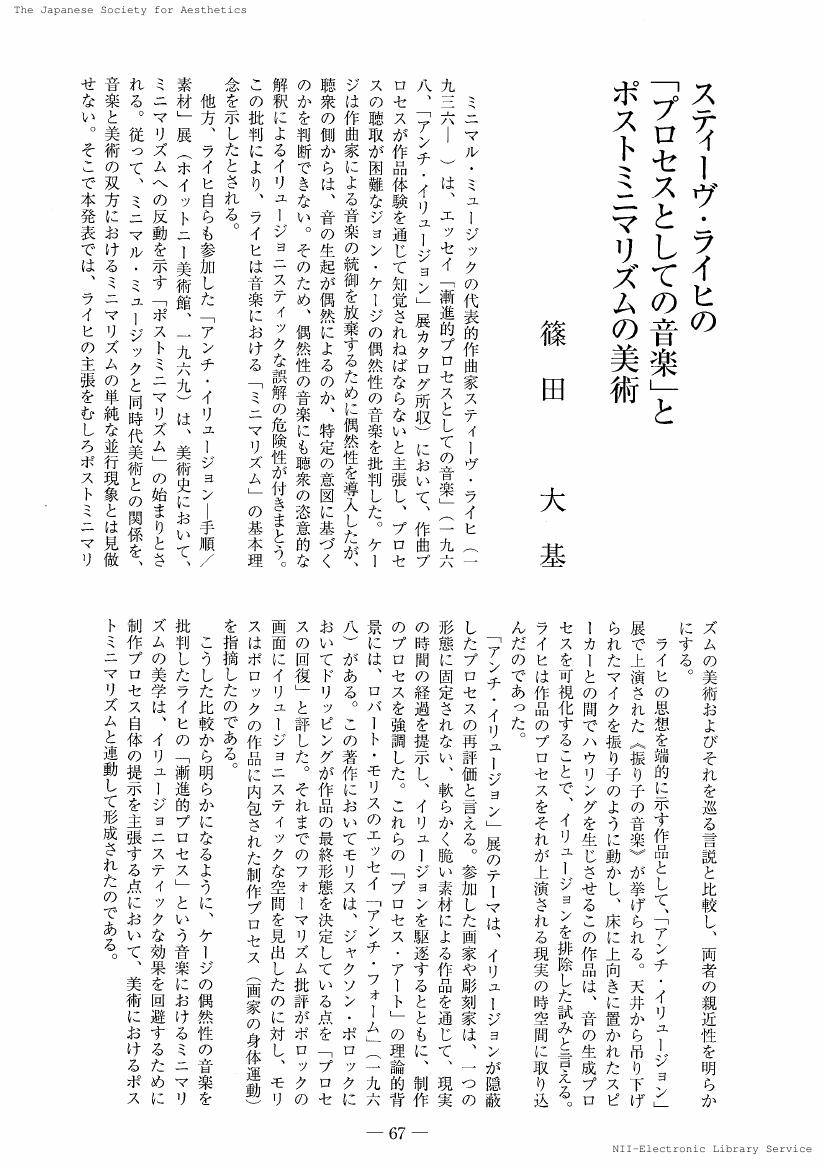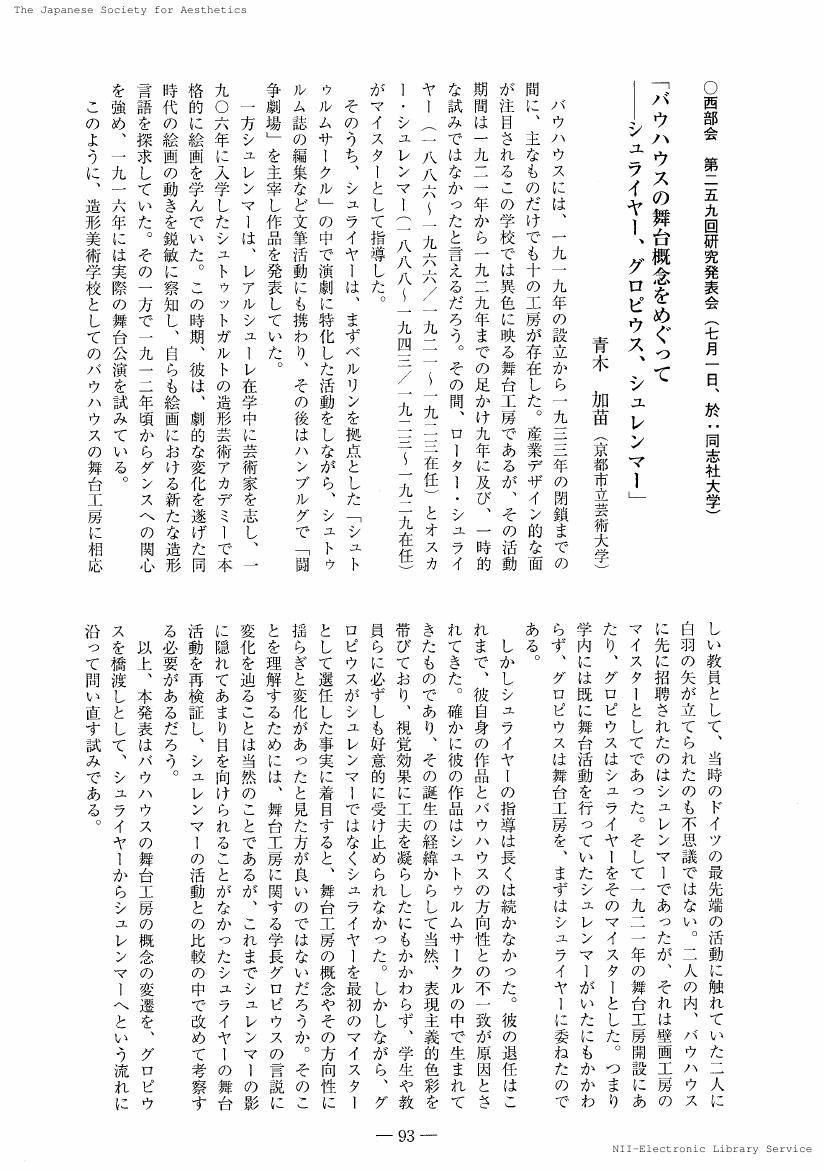- 著者
- 篠田 大基
- 出版者
- 美学会
- 雑誌
- 美学 (ISSN:05200962)
- 巻号頁・発行日
- vol.57, no.3, pp.67, 2006-12-31 (Released:2017-05-22)
- 著者
- 城丸 美香
- 出版者
- 美学会
- 雑誌
- 美学 (ISSN:05200962)
- 巻号頁・発行日
- vol.57, no.3, pp.68, 2006-12-31 (Released:2017-05-22)
- 著者
- 要 真理子
- 出版者
- 美学会
- 雑誌
- 美学 (ISSN:05200962)
- 巻号頁・発行日
- vol.57, no.3, pp.60, 2006-12-31 (Released:2017-05-22)
- 著者
- 河合 貞子
- 出版者
- 美学会
- 雑誌
- 美学 (ISSN:05200962)
- 巻号頁・発行日
- vol.57, no.3, pp.61, 2006-12-31 (Released:2017-05-22)
- 著者
- 木下 和重
- 出版者
- 美学会
- 雑誌
- 美学 (ISSN:05200962)
- 巻号頁・発行日
- vol.57, no.3, pp.62, 2006-12-31 (Released:2017-05-22)
- 著者
- 泉 美知子
- 出版者
- 美学会
- 雑誌
- 美学 (ISSN:05200962)
- 巻号頁・発行日
- vol.57, no.3, pp.51, 2006-12-31 (Released:2017-05-22)
- 著者
- 伊藤 亜紗
- 出版者
- 美学会
- 雑誌
- 美学 (ISSN:05200962)
- 巻号頁・発行日
- vol.57, no.3, pp.52, 2006-12-31 (Released:2017-05-22)
1 0 0 0 OA 工芸の製作における「反復」という概念(第五十七回美学会全国大会発表要旨)
- 著者
- 猪谷 聡
- 出版者
- 美学会
- 雑誌
- 美学 (ISSN:05200962)
- 巻号頁・発行日
- vol.57, no.3, pp.53, 2006-12-31 (Released:2017-05-22)
- 著者
- 江藤 匠
- 出版者
- 美学会
- 雑誌
- 美学 (ISSN:05200962)
- 巻号頁・発行日
- vol.57, no.3, pp.54, 2006-12-31 (Released:2017-05-22)
- 著者
- 呉 永三
- 出版者
- 美学会
- 雑誌
- 美学 (ISSN:05200962)
- 巻号頁・発行日
- vol.57, no.3, pp.55, 2006-12-31 (Released:2017-05-22)
- 著者
- 大石 昌史
- 出版者
- 美学会
- 雑誌
- 美学 (ISSN:05200962)
- 巻号頁・発行日
- vol.57, no.3, pp.56, 2006-12-31 (Released:2017-05-22)
1 0 0 0 OA アントン・マウフェのラーレン時代(第五十七回美学会全国大会発表要旨)
- 著者
- 太田 靖子
- 出版者
- 美学会
- 雑誌
- 美学 (ISSN:05200962)
- 巻号頁・発行日
- vol.57, no.3, pp.57, 2006-12-31 (Released:2017-05-22)
1 0 0 0 OA 写真と指示 : その類比についての分析の試み(第五十七回美学会全国大会発表要旨)
- 著者
- 岡本 源太
- 出版者
- 美学会
- 雑誌
- 美学 (ISSN:05200962)
- 巻号頁・発行日
- vol.57, no.3, pp.58, 2006-12-31 (Released:2017-05-22)
- 著者
- 小倉 康之
- 出版者
- 美学会
- 雑誌
- 美学 (ISSN:05200962)
- 巻号頁・発行日
- vol.57, no.3, pp.59, 2006-12-31 (Released:2017-05-22)
1 0 0 0 OA 「類似」概念の実効性(西部会第二五八回研究発表会,例会・研究発表会要旨)
- 著者
- 秋庭 史典
- 出版者
- 美学会
- 雑誌
- 美学 (ISSN:05200962)
- 巻号頁・発行日
- vol.57, no.2, pp.92, 2006-09-30 (Released:2017-05-22)
- 著者
- 青木 加苗
- 出版者
- 美学会
- 雑誌
- 美学 (ISSN:05200962)
- 巻号頁・発行日
- vol.57, no.2, pp.93, 2006-09-30 (Released:2017-05-22)
- 著者
- 金 正善
- 出版者
- 美学会
- 雑誌
- 美学 (ISSN:05200962)
- 巻号頁・発行日
- vol.57, no.2, pp.94, 2006-09-30 (Released:2017-05-22)
1 0 0 0 OA 八世紀日本彫刻の彩色材料 : 材料の性質と適性に関する問題を中心に
- 著者
- 國本 学史
- 出版者
- 美学会
- 雑誌
- 美学 (ISSN:05200962)
- 巻号頁・発行日
- vol.57, no.3, pp.1-14, 2006-12-31 (Released:2017-05-22)
The original coloring materials are remaining at arts and crafts in the 7th century to the 8th century, those coloring materials have been keeping use for ornaments of arts and crafts till the 17-18th century. In documents of the 7-8th century we can find many descriptions about coloring materials, it appears there was limitation to use coloring materials. I try to point out the reason of restriction to use coloring materials that is because of chemical character. There is no research which analyzes quality and characteristic of coloring materials themselves, and insists that chemical changes and chemical reactions cause restriction to use of coloring materials. Even if we analyze optically arts and crafts, we can't point out what coloring materials were used to perfectly. So it's necessary to refer documents which record how the coloring material was used, and in which amount used. In consideration of descriptions of documents and decorations examples of arts and crafts and chemical character of coloring materials, I would like to indicate that the restrictions to use of coloring materials are caused by the compatibility and the aptitude of the coloring material.
1 0 0 0 OA バウハウスの舞台概念をめぐって : シュライヤー、グロピウス、シュレンマー
- 著者
- 青木 加苗
- 出版者
- 美学会
- 雑誌
- 美学 (ISSN:05200962)
- 巻号頁・発行日
- vol.57, no.3, pp.29-42, 2006-12-31 (Released:2017-05-22)
Although Lothar Schreyer, who had some initial theatrical experience at the Sturm in Berlin, first headed up the Bauhaus theater workshop, the ideas and concepts of the workshop have been commonly associated with the other master of the workshop, Oskar Schlemmer. Schreyer left the Bauhaus because of discord between his work and the orientation of the Bauhaus under the direction of the first director Gropius. There is, however, the apparent influence of Schreyer in the theatrical concepts which Gropius stated several times, even after Schreyer's resignation. On the other hand, Gropius also had some ideas, which were not similar to Schreyer's, but closer to those of Schlemmer. In this paper, the characteristics of each master's theatrical concept are examined and compared with that of Gropius. Schreyer's theater can be defined as "a function to transmit implications" and Schlemmer's as "internalization of principles." With these classifications, it becomes possible to review the workshop in its early years, and demonstrate that inconsistency between Schreyer and the Bauhaus existed from the beginning. Yet, it is also true that while Schreyer left the Bauhaus, his concepts and ideas did not completely disappear: even in Schlemmer's theatrical concept, the influence of Schreyer can still be found.
1 0 0 0 OA 明治二十一年意匠条例と応用美術思想について(第五十七回美学会全国大会発表要旨)
- 著者
- 天貝 義教
- 出版者
- 美学会
- 雑誌
- 美学 (ISSN:05200962)
- 巻号頁・発行日
- vol.57, no.3, pp.50, 2006-12-31 (Released:2017-05-22)

















